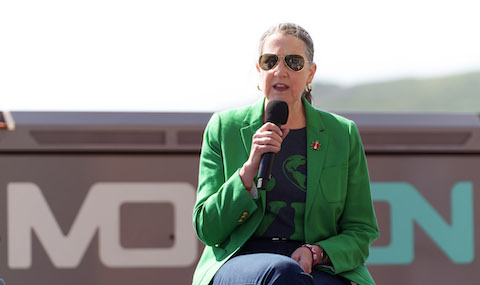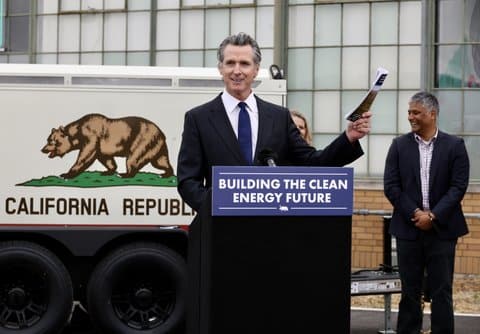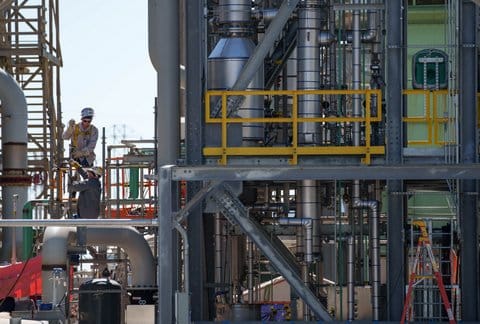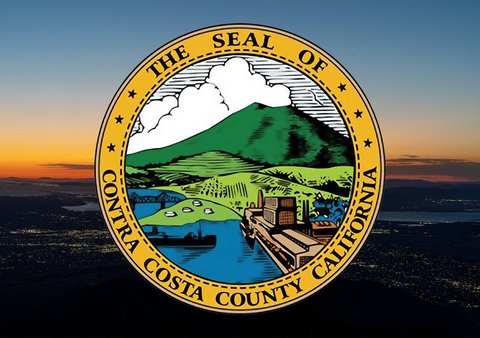
23 Apr PG&E Produced Greenhouse Gas-Free Energy for Retail Customers in 2023

PG&E CEO Patti Poppe said Monday at Craneway Pavilion that there “can actually be an affordable future for all citizens of California as we decarbonize the economy.”
By Tony Hicks
Bay City News
PG&E picked a sunny Earth Day at the Richmond shoreline Monday to announce two big achievements in the battle to produce emission-free energy and help California get to its goal of carbon neutrality in 2045.
Near the Moxion Power headquarters — with which PG&E is partnering to provide emission-free generators to outage areas — in front of the Rosie the Riveter Museum, PG&E officials said retail customers received 100% greenhouse gas-free electricity, for the first time, in 2023.
“In addition to that, we have made significant progress on our use of battery storage,” said PG&E CEO Patti Poppe. “We have 2,100 megawatts of battery storage on our system and have a target to add an additional 1,600 megawatts of battery storage by 2026. That is right around the corner.”
“We are very bullish on clean energy for California, and we’re proud to be the utility who can deliver that to our customers so successfully,” Poppe said.
PG&E has said publicly it wants to reach carbon neutrality by 2040 and to be removing more greenhouse gas from the atmosphere than it emits by 2050.
Poppe was part of a wind-blown outdoor discussion about the state’s energy future with Sunrun solar company CEO Mary Powell, California Independent System Operator Vice President of Stakeholder Engagement & Customer Experience Joanne Serina, and Sonal Larsen, Moxion’s director of public policy.
Addressing statewide efforts to eliminate greenhouse emissions, Powell said solar now has 1.7 million customers statewide.
“They have done the equivalent of taking two coal plants offline, which is really significant, and they also have contributed in a way that is the equivalent of 1.6 million cars coming off the road,” Powell said. “It’s just so powerful.”
Serina said CAISO is learning how to more effectively run the state’s power grid with the growth of new technologies, especially during hot summer moths requiring more grid management.
“We need more, more, more, right? In this case, less is not more, we need more … estimates (are) we need about 165,000 more megawatts of newly installed capacity on the grid,” Serina said. “To put that into perspective, we currently have 80,000 megawatts installed on the grid.”
Serina said CAISO has expanded grid capacity by 15,000 megawatts the past three years.
“We have to outpace ourselves to be able to put 70,000 megawatts on the grid in the next 10 years, and then another 17,000 megawatts on top of that the following ten years,” Serina said. “We have a marathon in front of us. Every technology helps and part of that equation is storage. We have about 10,000 megawatts of battery storage on the grid.”
Poppe said there doesn’t have to be winners and losers when it comes to entities working together to provide more clean power. She said, with new technology and recent fire-prevention measures requiring one-time cost increases, customers should actually see a reduction in rates.
“We can all win when have an optimized system that serves everyone,” Poppe said. “That can actually be an affordable future for all citizens of California as we decarbonize the economy.”
Poppe said PG&E has statistics showing reducing carbon emissions by 70%, particularly by switching from gasoline to electric vehicles, household energy spending can decrease 30%.
“It will be less expensive for households because they will be able to spend their hard-earned dollars on the most efficient fuel, which is electricity,” Poppe said. “When we have 100% energy delivering to a grid powering electric vehicles, that’s a decarbonized economy with 30% lower (spending) for household energy. I think that’s a future we can all get excited about.”
PG&E — which said the jump in carbon-free power gives it one of the cleanest power portfolios in the world — said its retail customers last year received 53% of renewable electricity from carbon-free nuclear power from Diablo Canyon Power Plant in San Luis Obispo County.
The utility also benefitted from wet winters bookending 2023, increasing its GHG-free hydroelectric energy. Dry years limit water power and require the company to tap other sources, such as natural gas.
The utility said large-scale solar accounts for its largest share of renewable energy, with 260 power-purchase agreements with solar providers totaling more than 6,000 megawatts (one megawatt powers about 750 homes). PG&E also owns 13 solar generation plants, mostly in the Central Valley.
PG&E said the state’s renewable energy sources sometimes produce more energy than needed, which is why PG&E has increased its battery storage capacity, to use solar and wind power-generated electricity at night, instead of natural gas-fired resources.
The utility has increased capacity with facilities brough online in 2023, including the 350-megawatt MOSS350 Energy Storage Project in Kern County and the 132-megawatt North Central Valley Energy Storage Project in San Joaquin County. As of January, PG&E said it possessed 35% of the nation’s behind-the-meter storage capacity.
Copyright © 2024 Bay City News, Inc. All rights reserved. Republication, rebroadcast or redistribution without the express written consent of Bay City News, Inc. is prohibited. Bay City News is a 24/7 news service covering the greater Bay Area.






No Comments